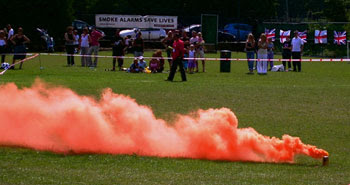Super Fly-Tipping

Let's say you find yourself strolling through the greater metropolitan region of southeast London. Perhaps your eye is caught by a small sculpture of what is no doubt supposed to be a lion, but due to its rotund, slightly porcine facial features, has actually begun to resemble a seal more than anything else.
Now, casting the eye down from this crowning glory, we see one of the distinctive blue signs of the borough of Lewisham with the following stern warning: "Fly tipping will not be tolerated." But was is "fly tipping" and why should it be so brusquely refused service?

Well, the Oxford English Dictionary defines fly-tipping as "the unauthorized dumping of building rubble, household refuse, or other waste, esp. while in the process of transporting it." So, therefore, as we consider the aforementioned sign in its broader context, we find that fly tipping is indeed being tolerated if not encouraged.

But why these two words, fly and tip? Well, in British English a "tip" designates what Americans would call a "heap"; thus, one hears the Brits talking about a house being "one big rubbish tip." Thus, by extension, fly tipping would seem to mean making a tip on the fly, as it were. And indeed, the fine borough of Lewisham—home to the Quaggy and the frightening overlord Optal-Max Shreek, as we have learned from past entries—seems to have no shortage of tip and run incidents.

While Old Ken will neither analyze their contents nor remark on their aesthetic configurations as presented in the photos above and below, I would like to use what one famous French person called "the rustle of language" to get at a possible motivation behind the fly-tipping phenomenon. It is this: when I have spent time in large urban centers, I have often heard the ground—the exposed earth, the green grass of a park or the pavement underfoot—as "the floor." To my mind, this seems like a horrible conceptual error, a kind of ontological corruption of the natural world born of an overly domesticated, depleted existence. Now, having taken that ill-fitting Heideggerian hat off, I continue. Ah, yes! So, if the ground is conceived as being "the floor," then—to extend the metaphor—the city as such might be thought of as the interior contents of one's house; in the words of Modest Mouse "I just bought a t-shirt that says 'The World is my Ashtray.'" So, to follow illogic with more, one can begin to see how fly-tipping and littering in general gets rationalized, as people seem to conceptualize it as the ethical equivalent of throwing their old newspaper on the floor at home.

I offer you that when confronted with their littering, many such people are hardly able to satisfactorily acquit their behavior. Old Ken recently had the pleasure of watching a particular assclown seated in a car at a stop light in front of a major research library in north London throw a banana peel out of his car window and onto a traffic island. Old people and absent-minded scholars use this island all the time. Had this man seen no cartoons? Was he just demonstrating profound sociopathic desires? Anyway, Old Ken picked up said banana peel and offered it back to this thug, who said he no longer was interested in having it. When asked to explain what exactly it was that gave him the right to through his litter on the ground in a public place, the best he could offer was a mumbled "I don't know." Indeed, he probably does not; but, the linguistic work that enables him to lazily describe the surface onto which he casts his peel as the floor had most likely already taken its insidious conceptual hold enabling such brutishness. Harumph!


























